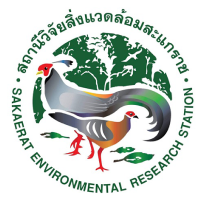Keywords :
Millipedes; Species Diversity; Forest Types; Consumption Rate; Growth Rate; Thyropygus
บทคัดย่อ :
Millipedes are the major saprophagous macroarthopods in tropical and subtropical regions and play important roles in wood and leaf litter decomposition and nutrient cycling. This study aimed to determine the diversity and distribution of millipedes in different forest types, investigate the relationships between millipede species and environmental factors, and quantify food consumption processes in the cylindrical millipede (Thyropyguscuisinieri). Millipede species diversity was studied in the Sakaerat Environmental Research Station, Nakhon Ratchasima province, Thailand.Millipedes and soil samples were collected concurrently between June 2010 and May 2011 from 30x30x30 cm3 sampling sites within 4 forest types: dry evergreen forest; dry dipterocarp forest; plantation forest; and ecotone. In total, 17 millipede species were found. The indices of diversity ranged from a high of 2.29 in dry evergreen forest to 1.59 in ecotone. 1.49 in dry dipterocarp forest, and 1.33 in plantation forest. The densities of millipedes in dry evergreen forest were significantly correlated with soil moisture (p < 0.01; r =0.970), air temperature p < 0.01; r = 0.887), phosphorus (p < 0.01; r = 0.265), organic carbon (p < 0.01; r = 0.911), and organic matter (p < 0.01; r = 0.911). The cylindrical millipedes (Thyropygus cuisinieri) were raised for 6 months under laboratory conditions. The efficiency of the conversion of ingested food of the leaf litter varied from 1.37(+-)0.58-6.85(+-)5.42%. The mean of the efficiency of conversion of digested food to biomass was 0.96(+-)0.31%. Furthermore, the mean approximate digestibility was 10.66(+-)3.74%.
เอกสารอ้างอิง :
Sukteeka, S., Punha, S., & Murray Potter, S. (2011) Millipede diversity in Sakaerat Environmental Research Station, Thailand, and leaf litter consumption in the cylindrical millipede (Thyropygus cuisinieri) in captivity.



